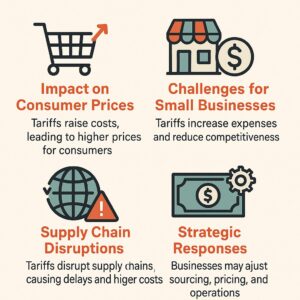
Tariffs are extra taxes on goods from other countries. When these taxes are added, bringing items into the country costs more. That can raise prices in stores. Small businesses might struggle because they have to pay more to get what they need. Small businesses often rely on imported materials or products, so these increased costs can strain their budgets. Small businesses might have to charge more to avoid losing money. This can make it harder for them to compete with bigger companies or cheaper options. This situation can lead to decreased sales and potential layoffs. Additionally, tariffs can disrupt supply chains, causing delays and further increasing costs. It’s important to understand how tariffs influence the economy and explore strategies to mitigate their effects. For those tracking economic shifts, reviewing an EP Wealth tariffs analysis may help clarify broader market trends. Learning how tariffs affect things can help people and businesses make better choices when prices and the economy change. By staying informed, stakeholders can better navigate the challenges posed by tariffs and seek opportunities to adapt.
Impact on Consumer Prices
When tariffs are placed on imported goods, the cost to bring these products into the country rises. Importers pass these costs to retailers, who then raise prices for customers. This can make everyday things like phones, clothes, and kitchen items cost more. When prices rise across the board, people may reduce their spending or choose lower-cost alternatives. As prices keep increasing, the cost of living can rise for everyone. Inflation can reduce the value of money and place more pressure on family budgets.
Challenges for Small Businesses
Small businesses usually have fewer resources than large corporations. When their costs go up due to tariffs, they may not be able to absorb the impact. Raising prices could drive customers away, but not raising them can reduce profits. Either choice can hurt the business. Smaller companies may also lack the bargaining power to get better deals or find new suppliers. This creates a tough situation where flexibility is limited, and decisions must be made carefully.
Supply Chain Disruptions
Tariffs can also make it harder to get the materials or products needed to run a business. Supply chains become more expensive or slower when companies have to switch to new sources. Delays in getting supplies can stop production and affect customer satisfaction. It also costs more to manage unexpected changes. These disruptions hit small businesses the hardest because they often don’t have extra inventory or backup plans. Being prepared for such changes is a key part of staying competitive.
Strategic Responses
There are ways for businesses to respond to tariffs. One is finding new suppliers that are not affected by tariffs. Another is changing how they price or package their products. Some may choose to focus on different goods or services that are less affected. Others might cut costs in other parts of their business. These changes can take a while, but can help businesses keep going and do well. Staying flexible and watching market trends closely can provide helpful direction.
Consumer Behavior Adjustments
As prices go up, consumers start making different choices. Some may buy less or switch to cheaper brands. Others might delay major purchases or avoid buying certain items altogether. These changes affect businesses, which may see slower sales. Companies that understand their customers and adjust quickly can stay ahead. This might involve offering new products, improving service, or finding better ways to show value to the customer.
Tariffs can change the way businesses operate and how consumers spend. They raise prices and create new challenges for small businesses trying to stay competitive. By finding new suppliers, managing costs, and adapting to customer needs, businesses can soften the impact. Consumers also adjust, making smarter buying decisions based on new prices. Staying prepared and informed makes a difference. Businesses that stay aware of these shifts are more likely to succeed, even in uncertain times. With the right plan, they can turn challenges into new chances for growth.
